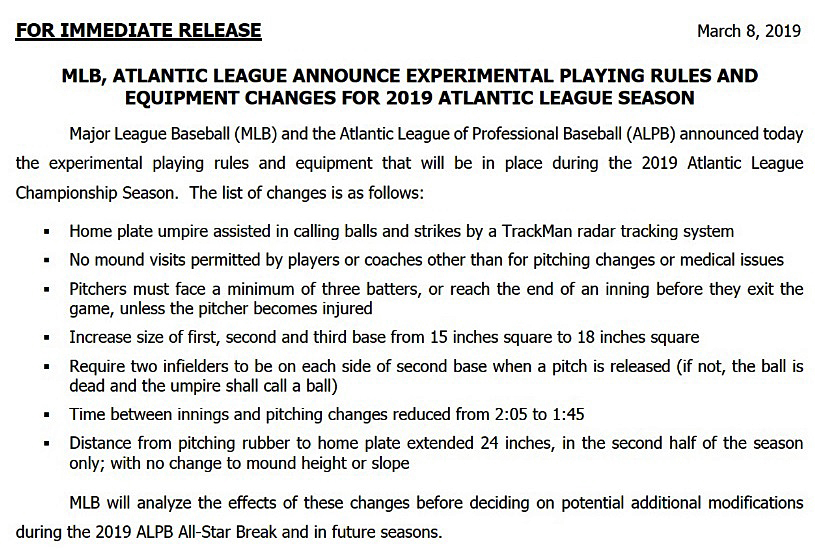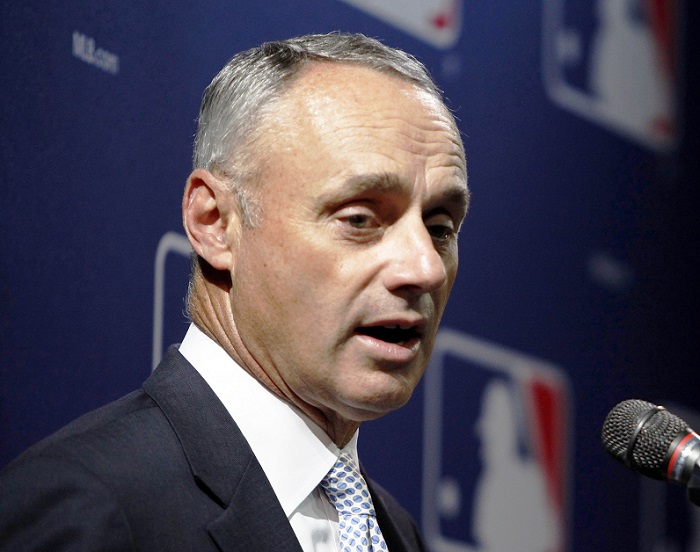Somewhere Abner Doubleday is rolling over in his grave.
The game that the famed Civil War general is credited with inventing (which has long since been debunked) is about to change … drastically.
On Friday morning, Major League Baseball (MLB) and the Atlantic League of Professional Baseball (ALPB), a well-respected (to this point, at least) independent baseball league, formally announced a series of very significant experimental rule and equipment changes that will be implemented immediately in the eight-team independent league beginning this season, with the understanding that some – or all – of them may find their way into MLB as soon as next season; at least if current MLB commissioner Rob Manfred has any say in the matter which, of course, he absolutely does.
Without editorializing or giving an opinion one way or the other, here are the forthcoming rule and equipment changes that are coming to the ALPB and may be coming to MLB:

Although a number of these rule changes will undoubtedly improve the current pace of play – Manfred’s apparent career goal and likely his eventual legacy – there are others that the commissioner will have a very difficult time getting past the Major League Baseball Players Association (MLBPA); especially those that will affect existing MLB records, more specifically pitching records, and pitchers’ health concerns.
Manfred and MLB could also be in for a major fight with regional sports networks and/or cable and television networks over that “between innings” thing. Keep in mind that many (most) major league teams rely on exclusive and proprietary regional sports networks to finance their respective franchises, such as the Yankees YES network and the Dodgers Spectrum SportsNet LA network, to name only two. A reduction of even 15 seconds would take millions of dollars in advertisement revenue away from them.

Again, I’m not going to editorialize or give my opinion on the imminent ALPB and potential MLB rule changes coming.
I’ll leave that to you.
* * * * *




 March 8th, 2019 at 12:00 pm
March 8th, 2019 at 12:00 pm  by Ron Cervenka
by Ron Cervenka  Posted in
Posted in 

I am totally for TrackMan calling balls and strikes. The home plate umpires have always been horrible at it and each umpire has their own strike zone which often changes as the game progresses. I think having a set strike zone will help generate more offense as the hitters can concentrate on a fixed zone instead of the current floating zone.
Instead of the 3 hitter minimum rule, they should try limiting the number of pitching changes to 2 once an inning begins. This way, you can still use a situational reliever, but it comes with more risk. It also protects you if your reliever is having an off day. Even a two batter minimum would be reasonable.
I also like the idea of a shift rule where 2 infielders must be on each side of the bag.
I don’t like changing the size of the bases at all. It will increase the difficulty in putting down a tag and will change the game too much. Same thing with the distance from the rubber to the plate. We don’t need to have cricket scores and the TrackMan strike zone will already help the offense.
I’m indifferent about the mound visits. I think if you get rid of them, pitchers will adjust. I’m all for speeding the game along, but at the same time, you can’t fit a timeless game into a box.
Well thought out response. I am in total lock-step with you on trackman, or any other system that brings conformity to the strike zone and I agree that it will improve offense. I really like your thought about mound visit rather than minimum batter rule. I think the shift rule of 2 infielders on each side of second base will be easily handled by ML teams. For a left handed pull hitter the second baseman positions himself in short right field before the pitch with the shortstop next to the third base side of second base; as the pitch is delivered the shortstop quickly moves to the first base side — could also distract the hitter as he moves to his new position. I do see a need for mound visits by the catcher during games; whether he sees the pitcher making a mechanical mistake, or when crossed up by a pitch and need to get signs squared away. At some point MLB should allow pitchers and catchers to wear ear buds so that coaches can communicate directly as teams do in the NLF for certain positions
Prediction. MLB and Players Association will agree to reduce the height of the pitchers mound for 2020. In January, 2019 the Journal of Science and Medicine in Sport published a report; “The influence of mound height on baseball movement and pitching biomechanics,” that concluded reducing mound height did not effect pitchers velocity, spin rate, or break. BUT lowering the pitching mound results in slightly lower fastball elbow and shoulder kinetics, which may possibly reduce the risk of pitching injury.
With no effects on pitches, even a small chance of reducing injuries to pitchers elbows and shoulders seems more than enough justification to lower mound height. I also believe mound height and slope of the mound should be monitored by MLB for conformity by all teams.
Trackman: A year ago I was opposed. Today I am very much in favor.
Mound visits: Asinine.
Minimum of three batters: Asininer. 59inarow’s idea is better, limit 2 pitching changes per inning.
Increase base size: Why?
Shift rule: We don’t need a rule. If the batters can’t deal with it themselves they don’t deserve to call themselves major league batters.
Time ‘tween innings: I don’t have enough time to pee as it is!
Pitching distance: Easily the asininest idea ever!
Whatever it is that home plate umpires do to the strike zone, it is what they have ALWAYS done. No, you weren’t there in the Babe’s playing days and none of the rest of us were either! To me, that means if they implement Trackman or any other electronic ball/striker determiner you can throw out all pitching records.They’ll be meaningless.
What’s to be gained by increasing the base size? Reduce “bang-bang” plays and thereby the time spent on replay reviews? I don’t get it.
“To me, that means if they implement Trackman or any other electronic ball/striker determiner you can throw out all pitching records.They’ll be meaningless.”
Wouldn’t that same logic apply to replay reviews? Or, for that matter, many other rule changes?
Back when The Babe played if a ball went foul after passing the foul pole it was ruled a foul. Though there is no record that Babe lost any HR’s that way I’m sure some batters did.
The only thing Trackman does is give more consistent pitch calls. I see nothing wrong with that.
Before any rules are added, or changed, for pace-of-play, MLB should hold home plate umpires accountable for enforcing the current rules: strike zone; 12 seconds for pitchers to deliver ball with no one on base; and, batters remain in box. If an umpire cannot, or will not enforce those rules then he should be relegated to umpiring bases, or sent back to the minors until he can demonstrate consistent proficiency. I do not consider the use of technology to be a rule change. Providing an assist to umpires to get calls right just makes sense, especially in calling balls and strikes.